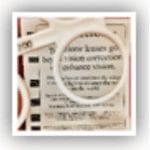Vision Therapy
What is vision therapy?
Vision therapy is a tailored program aimed to improve the coordination and efficient functioning and processing of the
visual system and to integrate the binocular vision skills with higher visual processing. Vision therapy links vision, spatial
skills, cognitive awareness and the process of auditory analysis and balance to facilitate remediation and enhancement of an
individuals visual abilities
20/20 vision acuity does not mean you have good vision. Vision is the ability to co ordinate both eyes together to enable the accurate direction of movement and enhance the cognitive awareness of text and other visual processing then linking those to auditory and physical stimuli. Stimulating visual processing outcomes learning ability and improves scholastic outcomes
Who would benefit from vision therapy?
Children and adults with problems like…
- Dyslexia
- Learning Difficulties
- Eye teaming problems, poor eye coordination
- Rehabilitation (e.g Visual Difficulties secondary to head/brain injury, stroke)
- Sports vision improvement
- Computer users
When is vision therapy necessary?
We determine your suitability for vision therapy by developing a knowledge of your symptoms, and an ocular systems review which will elicit any of the following:
1. Eye teaming disorders
2. Tracking disorders
3. Focusing disorders
4. Poor spatial and body awareness
5. Visual processing problems
Please download the attached pdf. Questionnaire and bring it with you to your appointment.
What does Vision Therapy Involve?
Therapy procedures, glasses, flippers and the use prisms, home training, in office training are integral components of the successful treatment of a vision problem. Each activities has increasing levels of complexity that with repetition and cognition allow the development and modification of the way we execute an action, in this case visual activities. It can be done on people of all age.
The duration of your course of vision therapy will vary depending on the nature and severity of the problem being treated and your specific needs and goals along with how quickly you or your child develops the skills required to move along each step of the procedure.
Treatment Goals
1. Treat existing visual problems to reduce eye alignment problems, eye coordination problems, poorly sustained near focus, inadequate eye-hand coordination and immature visual processing development.
2. Enhance the efficiency and comfort of visual function.
3. Help prevent some visual problems such as myopia development.
4. Correct amblyopia (lazy eye)
5. Improve spatial awareness, reduce reversals, and improve reading rate and comprehension.
6. Co-ordinate neural processing of visual, auditory and sensory stimuli to create an automation to processing of stimuli.
A child’s development can vary immensely from its peers. Vision also develops through movement and use! This also means that vision can be trained or learned through appropriate structured vision therapy.
Good vision consists of 3 components:

- Clarity: Ability to see fine details
- Comfort: Ability to sustain visual activity for a long period of time
- processing: Ability to analyse and interpret visual information
Visual Skills for Reading Enhanced by Vision Therapy.
1. Tracking Skills:
When Reading it is necessary for a child to keep their place along a line of text
2. Saccadic Skill:
Returning from the end of one line to the next with speed and accuracy
3. Focusing Skills:
Keeping the page in focus whilst tracking.
4. Visual-spatial skills:
Where am I on the page and which direction do I read in?
5. Visual Memory:
Word recognition and copying tasks, for example in writing, spelling and reading.
6. Short Term Visual memory:
Returning from the end of one line to the next with speed and accuracy
7. Sequencing:
Recognising the order of numbers or letters in words. Left to right progression when reading and writing.
8. Visual Discrimination:
Recognising subtle visual differences between letters(b/d) and words (was/saw or big/dig), reducing reversals and confusion and thus improving overall recognition.
Examples of Testing Procedures do we use?
1. Dyslexia Determination Test
2. Test of Visual Analysis Skills (TVAS)
3. Test of Visual Perceptual Skills (TVPS)
4. Test of Auditory Analysis Skills (TARS)
5. Reversals Frequency Test
6. Wold Sentence Copying Test
7. Binocular Vision Function: Fusional Reserves
8. Convergence Insufficiency Testing
9. Piaget Left-Right Awareness test
10. Retained reflexes testing.
Examples of Testing Procedures do we use?
We use a variety of equipment and exercises including but not limited to:
• Lenses/flippers
• Prisms
• Balance boards
• Brock strings
• Hart Charts
• Walking Rails
• Colorimetry
• FITS Computerised Vision Therapy
• Eye Champion Visual Memory and Co-ordination
• Computer generated tranaglyphs
Vision Therapy for Sports
Some sports people seem to have more time than others when hitting a ball or assessing what is happening on the field around them.
This ‘vision’ has little to do with the player’s ‘clarity of vision’; it is about peripheral awareness and efficient visual function. Whilst many sports people have developed these skills naturally, others need to learn to develop them!
Vision training activities are a structured serieslof exercises designed to maximise the efficiency of specific visual skills required for all different types of sports.
Examples of how vision therapy can lift your game:
• Cricket: Vision therapy may be utilised to increase visual efficiency of one or both eyes and improve concentration and balance skills. Many players have found improvements in fielding and batting with judging the flight of the ball and seeing the ball more clearly as it leaves the bowler’s hand.
• Football: peripheral (side) vision awareness can be developed with sports vision therapy. Activities involve improving central visual skills and then co-ordinating these skills with peripheral awareness.
• Tennis: Shots require locating exactly where the ball is while moving and aiming the eyes rapidly from one direction to another with varying clues for depth perception depending whether the ball is above or below your eye-line. Vision therapy can also assist your eye-hand coordination improving depth perception, serving, overhead shots and groundstrokes.
